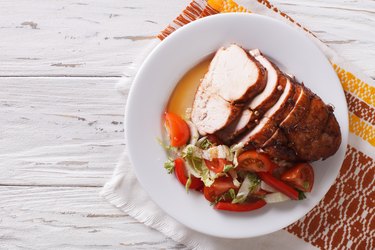
The house is warm and inviting, with the fragrance of roasting turkey wafting through the air. Your problem is that not all the invited guests have arrived, and your meal is ready to be served. Offering one more glass of wine before dinner to an already-buzzed crowd may prove hazardous to dinner table conversation. Keeping turkey warm and moist becomes a challenge, but with a few basic kitchen tools, your special dinner will rival a Norman Rockwell painting.
Tip
A meat thermometer is your best kitchen pal. Buy one that doesn't need to pierce the entire piece of meat, but simply pokes the surface to get a reading. An instant-read digital thermometer, while costly, is one of your most valuable kitchen investments.
Video of the Day
Understand a Turkey’s Cooking Time
Many of us remember our mothers getting up at 6 a.m. just to put the turkey in the oven to make sure it would be ready for our 4 p.m. dinner. Inevitably, the breast was dry, almost like cardboard, and the juicy thighs no longer oozing.
The science of roasting a turkey is simple: It all depends on the weight of the bird. The rule of thumb is to roast it for 20 minutes per pound, unstuffed. If you've stuffed the turkey, roast until the internal temperature of the stuffing reaches 165 degrees Fahrenheit.
Serving a Picture-Perfect Dinner
The internal temperature of your turkey reads 180F, the skin is golden and crisp, and it's time to take it out of the oven to rest. But dinner won't be served for at least another hour, and it's a struggle keeping the turkey warm until the time it's ready to be carved. Wait about 20 minutes to let the internal temperature subside and stop the meat from continuing to cook; then use a sheet of aluminum foil to cover the bird.
A kitchen towel placed over the foil helps keep the meat warm and moist until it's time to be carved and served. For another option, cover the bird with foil and return it to a low-temperature, 200F oven. Place a pan of water under the turkey to create steam, which contributes to moistness.
Spatchcock the Turkey
No, it's not a dirty word. Spatchcocking a bird involves removing its backbone and laying it flat on the baking tray. Advantages of a spatchcocked turkey are:
- It takes less time to cook. Think 1‒1/2 hours for a 12-pound bird.
- The entire turkey is roasted evenly, and the breast doesn't get overcooked while the thighs finish.
- All of the skin is browned and crispy.
The one disadvantage of spatchcocking is that the oven is set at 450F, which probably eliminates using the oven to cook another dish at the same time.
Resting the bird in the refrigerator once it's spatchcocked and before you roast it dries out the skin, making for crispier skin after the roast.
Roast the Turkey the Day Before
Eliminate the holiday rush by roasting the turkey the day before. Let it sit for about 30 minutes; then carve it into serving-size pieces. The breast should be at least 3/4-inch thick to maintain moisture. Keep the pieces close together to maintain moistness. Then instead of keeping the turkey warm, cover it tightly with plastic wrap and refrigerate until the big day.
On the day of the feast, separate the pieces and bring the turkey back to room temperature. Drizzle some warm chicken stock onto the carved turkey pieces and reheat it in a very hot oven, about 450F, for less than 15 minutes. Your turkey is still moist, and the only casualty will be the skin, which won't be as crisp as if the turkey had just come from the oven.
Turkey Safety Is Paramount
The Centers for Disease Control and Prevention provides tips to help protect your guests from food poisoning.
- Defrost the turkey in the refrigerator, never on the kitchen counter where bacteria can grow.
- Wash your hands frequently after handling an uncooked turkey.
- Stuffing prepared outside the turkey is safer, but if you insist on cooking it inside the bird, stuff it just before roasting. Be sure the stuffing temperature reaches 165F before removing the turkey from the oven. And never refrigerate the turkey with the stuffing still inside.
Check out this related video from ExpertVillage on Youtube
- The Strategist: This $99 Meat Thermometer Helped Me Become a Better Home Cook in Seconds
- Shelf Life Advice: Yikes The Turkey is Done, But the Guests are Delayed! How Do I Keep My Thanksgiving Dinner Warm?
- Taste of Home: How to Spatchcock a Turkey
- All Recipes: Turkey Cooking Time Guide
- The Yummy Life: How to Make Ahead and Reheat Turkey
- Centers For Disease Control and Prevention: Food Safety Tips for Your Holiday Turkey